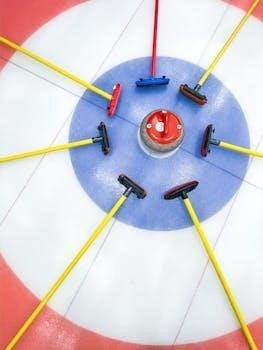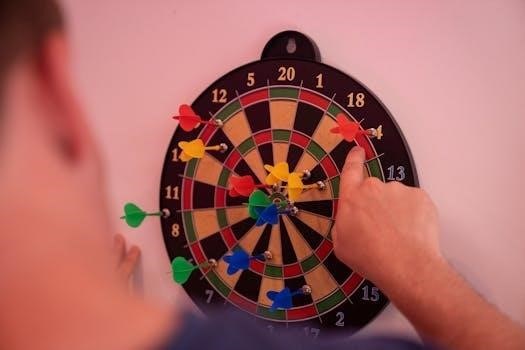
hook and ring game instructions
Hook and Ring Game Instructions⁚ A Comprehensive Guide
Get ready to master the hook and ring game! This comprehensive guide provides all you need․ From understanding the game’s objective to setting up your playing area, we’ll equip you with the knowledge to enjoy this exciting activity․
The hook and ring game, also known as Bimini Ring Game, Tiki Toss, or Wall Hooky, presents a simple yet engaging challenge suitable for all ages․ Originating from Caribbean bars, it’s quickly becoming a staple in homes and pubs around the globe․ The game requires players to swing a ring attached to a string․ The challenge is to land the ring successfully on a mounted hook․
Its easy setup and straightforward gameplay make it a fun and accessible option for parties, gatherings, or even a solitary test of skill․
Origins and History
Delve into the captivating story behind the hook and ring game․ We’ll explore its possible roots and how it has evolved into the popular pastime enjoyed today․ Discover interesting facts about its journey․
Caribbean Roots and Global Popularity
The hook and ring game is believed to have originated in the Caribbean Islands, becoming a beloved bar game․ Its simple yet addictive nature has propelled it to global popularity․ You will discover its journey from island bars to homes worldwide, and learn how it has been adapted and embraced by different cultures․ Its appeal lies in its accessibility and fun, making it perfect for any gathering․
Traditional Names⁚ Bimini Ring Game, Tiki Toss, Wall Hooky
The hook and ring game, though universally recognizable, goes by various names depending on location․ “Bimini Ring Game” hints at its Caribbean origins․ “Tiki Toss” evokes a playful, tropical vibe, often associated with beach bars and luaus․ “Wall Hooky” is a more straightforward descriptor, emphasizing the game’s wall-mounted setup․ Regardless of the name, the core gameplay remains the same, offering easy entertainment․ Embrace the local terminology!
Setting Up the Game
Proper setup is crucial for optimal gameplay․ This section details the steps for securely mounting the board and hook, ensuring consistent play․ We’ll also discuss the importance of string length in balancing challenge and accessibility․
Securing the board and hook is paramount for a stable and enjoyable game․ Begin by selecting a suitable wall or surface, ideally indoors or outdoors․ Position the board approximately five feet from the ground, ensuring it’s level for fair play․ Use appropriate hardware, such as screws or nails, to firmly attach the board to the wall․ Next, mount the hook, ensuring it faces upwards․ A common practice is to position the string five feet away from the board․ Double-check the stability of both the board and hook before proceeding․
Optimizing string length and placement is key to balancing challenge and enjoyment․ Position the ceiling hook around 5 feet from the game board․ Remember, a longer string increases difficulty․ The string should allow the ring to swing freely towards the hook․ Adjustments might be needed depending on the player’s skill level and the available space․ Ensure the string doesn’t encounter obstructions․ Test swing the ring several times to fine-tune the string length․ The goal is to create a setup that is challenging but achievable, promoting engaging gameplay for all․

Basic Gameplay Rules
The basic gameplay revolves around swinging the ring to catch it on the hook․ Players take turns, aiming for successful hooks․ Scoring can vary, but the core objective remains consistent․ Let’s explore more․
Objective⁚ Landing the Ring on the Hook
The primary objective of the hook and ring game is simple yet challenging⁚ successfully swing the ring attached to a string and land it securely on the mounted hook․ This requires a combination of skill, coordination, and a bit of luck․ Players must find the right momentum and angle to achieve this satisfying connection․ Mastering this skill is essential․ This makes the game fun for all involved․ This is the first part of enjoying the hook and ring game․
Taking Turns and Scoring Points
In a standard hook and ring game, players take turns swinging the ring towards the hook․ After each player has had the agreed-upon number of swings, scoring begins․ A successful hook typically earns one point․ However, point values can be customized based on house rules․ The first player to reach a predetermined number of points, often 11, 21, or any agreed number, wins the game․ Ensure fair play by adhering to the agreed-upon rules and turn order․

Variations and Competitive Rules
Elevate your hook and ring game with exciting variations․ Explore competitive rule sets for skilled players․ Discover new ways to play, keeping the game fresh and engaging for enthusiasts of all levels․
Standard Rules⁚ First to a Set Number of Points
The most common way to play involves setting a target score․ Players take turns swinging the ring, with each successful hook earning a point․ The first player to reach the predetermined number of points, such as 10, 15, or 21, wins the game․ This straightforward approach is perfect for casual play and friendly competition․ This is a simple way to keep it fun, especially during football game day events․
H-O-R-S-E Spin-off⁚ Matching Successful Hooks
Inspired by the classic basketball game H-O-R-S-E, this variation adds a strategic twist․ The first player attempts a hook․ If successful, the next player must replicate the same hook․ Failure to match earns a letter․ Accumulate H-O-R-S-E to be eliminated․ The last player remaining wins․ This version encourages creative shots and tests players’ ability to mimic each other’s techniques․ This is just like the basketball game, players must match successful hooks․
21 Point Rule and Tiebreakers
A prevalent scoring system involves racing to 21 points․ A successful ring landing typically awards one point, but house rules can adjust this․ In case of a tie, players continue taking turns until one surpasses the other, ensuring an ultimate winner․ Each player is entitled to the same number of plays․ This adds excitement and suspense to the game․ If there’s a tie score, players will continue playing until one achieves a winning score, ensuring the same number of turns for each player․

Customizing the Game
The beauty of the hook and ring game lies in its adaptability․ Feel free to tweak the rules to suit your preferences and skill levels․ This allows for a personalized and engaging experience for everyone involved․
Adjusting Rules for Fun and Skill Level
One of the great aspects of the hook and ring game is its adaptability․ You can easily modify the rules to create a more enjoyable and balanced experience for players of all skill levels․ For beginners or younger players, consider shortening the string or decreasing the distance to the hook․ This will make it easier to land the ring and keep them engaged․
Conversely, for more experienced players, you can increase the difficulty by lengthening the string or adding obstacles․ Experiment with different scoring systems or handicaps to level the playing field and ensure everyone has a chance to win․ Remember, the goal is to have fun!
House Rules and Point Allocations
To personalize your hook and ring game experience, establish house rules․ These can address any aspect of gameplay, from permissible throwing techniques to dispute resolution․ For instance, you might specify whether underhand or overhand throws are allowed, or how to handle situations where the ring partially lands on the hook․
Consider adding point allocations for special achievements․ Award bonus points for consecutive successful hooks, trick shots, or landing the ring with a specific spin․ These additions can inject excitement and friendly competition into the game, ensuring an engaging experience for everyone․ Feel free to experiment and create your own unique rules!

DIY Hook and Ring Game
Embark on a fun project by creating your own hook and ring game! This section details the materials required and provides a step-by-step guide to building a personalized game for hours of entertainment․
Materials Needed for a DIY Game
To embark on your DIY hook and ring game journey, gather essential materials․ You’ll need a wooden board as the backboard, a sturdy metal hook, and a suitable ring—often an O-ring will work perfectly․ Secure some durable string or rope to connect the ring․ Don’t forget screws or nails for mounting the board․ A measuring tape, drill, and sandpaper will also prove useful in constructing a smooth and functional game․ These materials ensure a safe and enjoyable gaming experience․ You can customize the look with paint or stain!
Step-by-Step Construction Guide
Begin by sanding the wooden board to a smooth finish․ Mark the spot for the hook, usually centered at the top․ Pre-drill a hole and securely attach the metal hook․ Measure and cut the string to your desired length․ Attach one end of the string firmly to the ring․ Then, securely fasten the other end to a point above or near the hook․ Test the swing of the ring, adjusting the string length if needed․ Finally, mount the board on a wall at your preferred height․
Hook and Ring Game Set-Up
Proper setup is key for optimal gameplay! This section details mounting the board and hook, and string length considerations․ Follow these guidelines for a balanced and enjoyable hook and ring experience with friends and family․
Mounting the Board and Hook
Begin by selecting a suitable location, indoors or outdoors, ensuring ample space for players to swing the ring․ Mount the board securely on a wall at a height of approximately five feet, though this can be adjusted to suit player preferences․ Position the hook five feet away from the board, typically on a ceiling or overhang, maintaining a similar height․ Use appropriate hardware to ensure a stable and safe setup․ Remember that slight adjustments may be necessary based on ceiling height․ Ultimately, prioritize a setup that allows for comfortable and enjoyable gameplay for all participants․
String Length and Placement Considerations
The string length is crucial, directly impacting the game’s difficulty․ A longer string increases the challenge, demanding greater precision and swing control․ Conversely, a shorter string makes it easier to land the ring on the hook․ Position the string’s anchor point strategically, typically above and slightly behind the hook․ Experiment with different string lengths to find the sweet spot that balances challenge and enjoyment․ Consider adjusting the placement based on player skill levels․ Ensure the string allows a free, unobstructed swing path for optimal gameplay and consistent results․
Safety Considerations
Prioritize safety while playing the hook and ring game․ Ensure a clear, unobstructed playing area․ Keep children supervised and be mindful of swing paths to prevent accidental injuries during enthusiastic gameplay․
Ensuring a Safe Playing Environment
Creating a safe environment is crucial for enjoying the hook and ring game without incident․ Begin by selecting a playing area free from obstacles and hazards․ Ensure sufficient overhead clearance to accommodate the swinging ring․ Keep bystanders at a safe distance from the active player․ Adequate lighting is essential, especially during evening play․ Regularly inspect the game components, including the string and hook, for wear and tear․ Replace any damaged parts promptly to prevent unexpected breakages and potential injuries․ Clear communication of safety guidelines to all players is vital․
Avoiding Injuries During Play
To minimize the risk of injuries while playing the hook and ring game, prioritize caution and awareness․ Avoid standing too close to the swinging ring to prevent accidental hits․ Refrain from excessive force when swinging, as this can lead to strain or imbalance․ If playing with others, establish clear turn-taking protocols to avoid collisions․ Be mindful of slippery surfaces, especially when playing outdoors․ Ensure proper footwear to maintain stability․ Take breaks to prevent fatigue, which can impair coordination and increase the likelihood of accidents․ By following these precautions, you can enjoy a safe and fun experience․